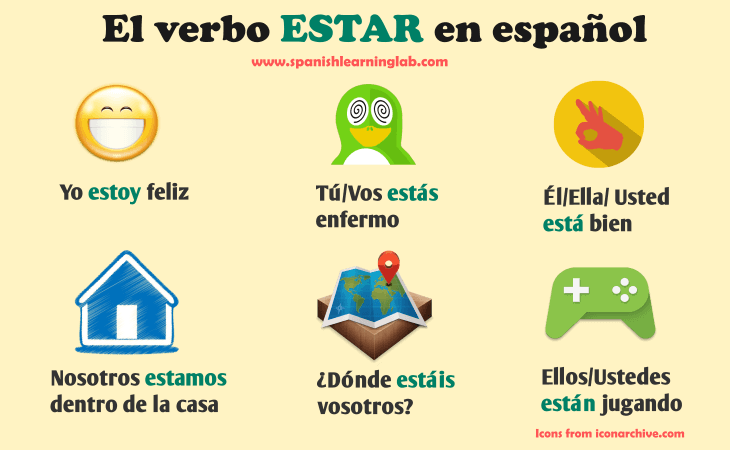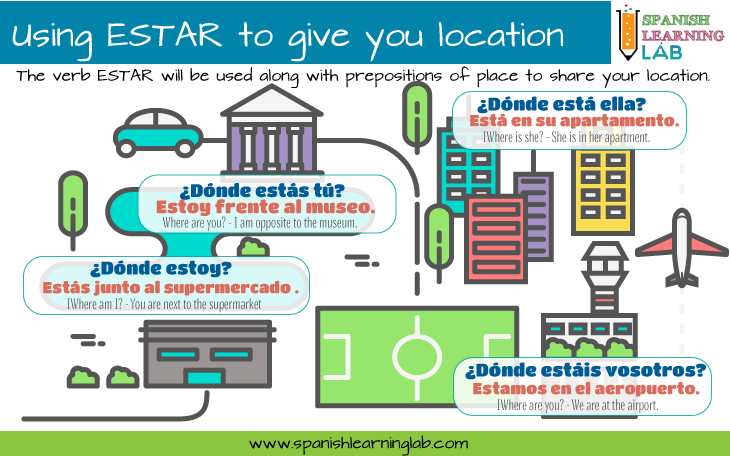SER and ESTAR are the two forms of the verb to be in Spanish. ESTAR is an extremely important and useful irregular verb to master in the language. In this lesson, we will learn to conjugate this verb and how to make sentences using ESTAR. You will have the chance to test yourself at the end of the lesson with an interactive quiz. Let’s begin…
Introductory video: Using SER and ESTAR in Spanish
We will begin the lesson with a short video explaining the basics about the verbs SER and ESTAR in Spanish. The video includes several examples of situations where we might use them. Pay attention to the examples using ESTAR in the video, and the main differences between SER and ESTAR. Make sure to stick until the end of the video to understand the rest of the lesson more easily.
How to conjugate ESTAR in Spanish in the present tense
Since ESTAR is an irregular verb, “un verbo irregular”, it will change depending on the subject of the sentence. The verb ESTAR will be conjugated like this for each subject pronoun in Spanish:
| Subject | Verb ESTAR | Translation |
| Yo | estoy | I am |
| Tú/vos | estás | You are |
| Él/Ella/Usted | está | She is |
| Nosotros | estamos | We are |
| Vosotros | estáis | You are (in Spain) |
| Ellos | están | They are |
Just like we do with SER, the other form of the verb BE in Spanish, we must memorize the different forms for each pronoun for the verb ESTAR. Remember, you can still omit the pronoun for most sentences in Spanish as long as you use the correct conjugation of the verb. For simple sentences, we just need to follow the chart above and add a complement to our sentences this way:
- Yo estoy enojado. (I am angry)
- Tú estás hambriento. (You are hungry)
- Él está enfermo. (He is sick)
- Nosotros estamos comiendo. (We are eating)
- Vosotros estáis ocupados. (You are busy)
- Ellos están trabajando. (They are working)
From these examples, we can tell that ESTAR can be used to talk about temporary states and to talk about actions in progress too. Please remember to put a tilde over the right vowel when needed. Here is a picture showing how to conjugate ESTAR in Spanish for all the pronouns, plus a few more sample sentences with this verb.

How to Make Sentences using ESTAR in Spanish
Using ESTAR with conditions and emotions
One of the most popular uses of ESTAR is for talking about physical or emotional conditions, health or any other temporary states in Spanish. These conditions and emotions are often represented by adjectives like enfermo (sick), enojado (angry) or hambriento (hungry) that tend to change over time. For instance, today someone might be “enfermo” and tomorrow “saludable”. Moreover, ESTAR will be used when talking about the weather conditions in Spanish, the seasons, days and months we are in.
Listen to some examples of sentences using ESTAR with conditions and emotions in Spanish:
|
Yo estoy feliz (with feelings and emotions)
I am happy
|
|
Estoy enfermo (with health state and omitting the pronoun YO)
I am sick
|
|
Tú estás emocionado (with feelings – sentimientos)
You are excited
|
|
¿Cómo estás (tú)? (asking for states)
How are you?
|
|
Él está de acuerdo (for opinions – not a literal translation)
He agrees
|
|
La comida está helada (to describe the state of something)
The food is cold
|
|
Estamos en enero (with months of the year)
We are in January
|
|
Ellos están en primavera (right now they are in this season)
They are in spring
|
Using ESTAR with prepositions of location
Another very common use of ESTAR is to indicate the location of things or people. To do so, we will use ESTAR with prepositions of place in Spanish such as “en, junto a, frente a” and so on. These kinds of sentences are very useful for giving directions of places as well, just like this:
- El perro está dentro de la casa. (The dog is in the house)
- Las tiendas están sobre la avenida central. (Las tiendas están sobre la avenida central.)
The following picture shows more ways to use ESTAR along with prepositions of place for this purpose:

Here are some examples with ESTAR plus prepositions to talk about location, focusing on the conjugations for the pronouns NOSOTROS and VOSOTROS.
|
Nosotros ya estamos aquí (notice the word for already is placed after the pronoun)
We are here already
|
|
Estamos en Estados Unidos
We are in the US
|
|
¿En qué piso estáis vosotros? (using the preposition of place EN)
You are excited
|
|
¿Vosotros estáis frente a la casa o detrás de la casa?
Are you in front of the house or behind it?
|
Using ESTAR for the present progressive
ESTAR plays the role of an auxiliary verb for the present progressive in Spanish, that is, actions in progress or something we call “perífrasis durativas” in the language. ESTAR will continue to be conjugated the same way for all pronouns as it was done previously in the present tense, but we will add a verb in gerund form to make sentences like these ones:
- Yo estoy estudiando. (I am studying)
- Tú estás jugando. (You are playing)
- Nosotros estamos mirando televisión. (We are watching television)
Notice that Spanish gerunds will end in “-ando” or “-iendo”, something we cover in detail in another lesson. Here is the last group of examples of sentences using ESTAR with the present progressive for actions in progress:
|
TRABAJAR – Ella está trabajando
She is working
|
|
HABLAR – Ella está hablando
Speak – She is speaking.
|
|
COMER – Él está comiendo.
To eat – He is eating.
|
|
VIVIR – Estoy viviendo en otra ciudad.
To live – I am living in another city.
|
Related PDF Worksheets:
- The verb SER in Spanish
- The verb ESTAR in Spanish
- Verbs and actions in progress in Spanish
- The Present Progressive in Spanish
- Common Actions in Spanish
- Adjectives for Feelings and Emotions
- The House and Prepositions of Place
- Common Irregular Verbs in Spanish
- Conjugating Irregular Verbs in Spanish
- Irregular Verbs in Spanish in the Present Tense
- Prepositions of Place in Spanish (classroom objects + sentences)
